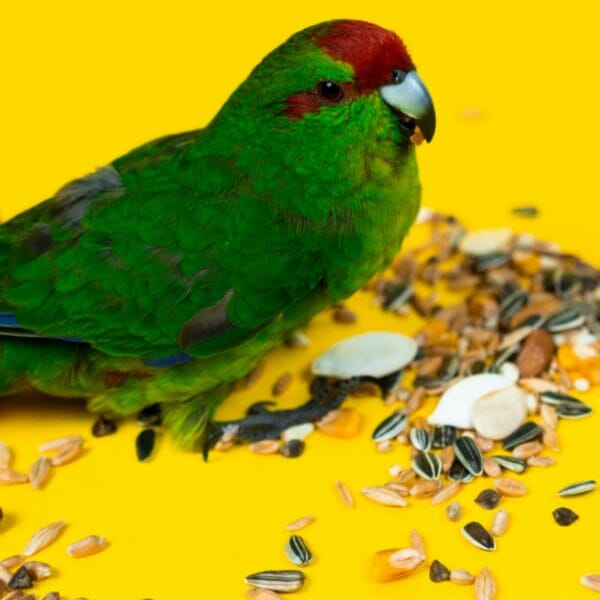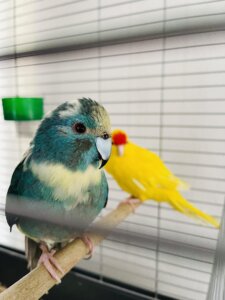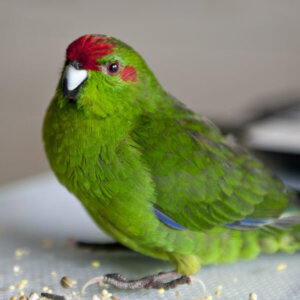Can Kakarikis Eat Lettuce?: Nutritional Benefits & Risks
Yes, Kakarikis can eat lettuce. But, it’s important to offer it in moderation.
Lettuce provides hydration and some nutrients, but too much can cause digestive issues. Kakarikis, vibrant and active parakeets, need a balanced diet. Fresh veggies, including lettuce, are part of their diet. But not all lettuce types are suitable. Some lettuces, like iceberg, lack nutrients and contain too much water.
This can lead to diarrhea and health problems. Romaine or leaf lettuce are better choices. They offer more vitamins and minerals. Always wash lettuce thoroughly before feeding. This removes pesticides and dirt. Introduce new foods slowly to monitor for any adverse reactions. Lettuce can be a healthy treat when given correctly, supporting your Kakariki’s overall well-being.

Credit: www.facebook.com
Introduction To Kakarikis
Kakarikis, small parrots from New Zealand, enjoy a varied diet. Lettuce can be a healthy addition to their meals.
Kakarikis are vibrant and lively parrots. They are also known as New Zealand parakeets. These birds are famous for their playful behavior. Many bird lovers adore them for their bright colors and friendly nature.Who Are Kakarikis?
Kakarikis are small parrots native to New Zealand. Their name means “small green parrot” in the Maori language. They come in two main types: the red-crowned and the yellow-crowned. Both types are very active and curious. Kakarikis love to explore their surroundings. They are social birds and enjoy interacting with their owners. These parrots are also known for their unique vocalizations. They can mimic sounds and even learn simple words.Common Dietary Habits
Kakarikis have a varied diet. In the wild, they eat seeds, fruits, and insects. In captivity, their diet should include fresh fruits and vegetables. It’s important to provide a balanced diet for them. Leafy greens like lettuce can be part of their diet. But moderation is key. Too much lettuce can cause digestive problems. Always wash the lettuce thoroughly before feeding. This removes any pesticides or chemicals. Offering a variety of foods keeps Kakarikis healthy. They enjoy foods like apples, carrots, and spinach. Avoid giving them avocado and chocolate. These foods are toxic to parrots. “`
Credit: www.northernparrots.com
Lettuce Varieties
Not all lettuces are the same. Different types offer different benefits. Let’s dive into the most common lettuce varieties and their nutritional values for your pet Kakarikis.
Types Of Lettuce
There are several types of lettuce, each with unique characteristics. Some of the popular varieties include:
- Romaine Lettuce: Tall, dark green leaves. Crunchy texture.
- Iceberg Lettuce: Pale green leaves. Crisp and watery.
- Butterhead Lettuce: Soft, tender leaves. Mild flavor.
- Leaf Lettuce: Loose leaves. Comes in red or green.
Nutritional Content Of Lettuce
Each type of lettuce has different nutritional content. Here’s a quick comparison:
| Lettuce Type | Calories | Vitamin A (%) | Vitamin C (%) |
|---|---|---|---|
| Romaine | 8 | 81 | 15 |
| Iceberg | 10 | 7 | 3 |
| Butterhead | 13 | 70 | 6 |
| Leaf | 5 | 47 | 4 |
Note that Romaine and Butterhead are rich in Vitamin A. Iceberg is low in nutrients. Leaf lettuce is a good balance of vitamins.
Choose the right lettuce to keep your Kakarikis healthy.
Nutritional Benefits Of Lettuce For Kakarikis
Lettuce is a popular vegetable among bird owners. It provides many nutritional benefits to Kakarikis. This leafy green is not only safe but also beneficial for these lively parrots. Let’s explore the advantages of feeding lettuce to your Kakariki.
Vitamins And Minerals
Lettuce is rich in essential vitamins and minerals. These nutrients support the overall health of Kakarikis. Here are some key vitamins and minerals found in lettuce:
- Vitamin A: Supports vision and immune function.
- Vitamin K: Helps with blood clotting and bone health.
- Folate: Important for cell division and growth.
- Calcium: Necessary for strong bones and beak.
- Potassium: Helps regulate fluid balance and muscle function.
Hydration Benefits
Lettuce has a high water content. This makes it an excellent source of hydration. Kakarikis can easily become dehydrated, so feeding them lettuce helps keep them hydrated.
| Nutrient | Benefit |
|---|---|
| Water | Keeps Kakarikis hydrated |
| Fiber | Supports digestive health |
Besides hydration, the fiber in lettuce helps with digestion. Ensuring your Kakariki gets enough water and fiber is crucial for their health.

Credit: feistyfeathers.com
Potential Risks Of Feeding Lettuce
Feeding lettuce to your Kakarikis might seem harmless. But there are potential risks. The following sections will explore these risks in detail.
Pesticide Concerns
Lettuce often contains pesticides. These chemicals can be harmful to Kakarikis. Even a small amount might be dangerous. Always wash lettuce thoroughly. Better yet, choose organic lettuce. This reduces the risk of pesticide exposure.
Digestive Issues
Lettuce has high water content. This can cause digestive issues in Kakarikis. They might experience diarrhea or loose stools. Too much lettuce can upset their stomach. It’s best to feed lettuce in moderation.
| Risk | Details |
|---|---|
| Pesticide Exposure | Can harm Kakarikis. Wash lettuce thoroughly or choose organic. |
| Digestive Problems | High water content can cause diarrhea. Feed in moderation. |
- Wash lettuce before feeding.
- Feed lettuce in small amounts.
- Monitor your bird’s digestive health.
Safe Lettuce Feeding Practices
Feeding your Kakarikis lettuce can be a healthy addition to their diet. Yet, it is important to follow certain practices to ensure their safety. This section will guide you through the best methods for feeding lettuce to your feathered friends.
Organic Vs Non-organic
Choosing between organic and non-organic lettuce is a critical step. Organic lettuce is grown without harmful pesticides. These chemicals can be toxic to Kakarikis. Non-organic lettuce may contain pesticide residues. These residues can harm your bird’s health over time.
| Type | Pros | Cons |
|---|---|---|
| Organic Lettuce | No harmful chemicals, safer for birds | More expensive, less available |
| Non-Organic Lettuce | More affordable, widely available | Pesticide residues, potential health risks |
Proper Washing Techniques
Washing lettuce properly is essential to remove any dirt or chemicals. Follow these steps for safe preparation:
- Rinse the lettuce under cold running water.
- Gently rub the leaves to remove any residue.
- Soak the lettuce in a bowl of water with a teaspoon of vinegar for 5 minutes.
- Rinse again under cold water to remove the vinegar taste.
- Dry the leaves with a clean towel or a salad spinner.
These steps help ensure the lettuce is clean and safe for your Kakarikis to enjoy.
Alternative Greens For Kakarikis
Ensuring a balanced diet for your Kakarikis is essential for their health. While lettuce can be a part of their diet, offering alternative greens can provide more nutritional benefits. Let’s explore some healthy leafy green options and their nutritional comparisons.
Leafy Green Options
- Spinach – Rich in iron and vitamins A and C.
- Kale – Packed with antioxidants and calcium.
- Collard Greens – High in fiber and vitamin K.
- Swiss Chard – Contains magnesium and potassium.
- Arugula – Offers a good amount of folate and calcium.
Nutritional Comparisons
| Green | Key Nutrients | Benefits |
|---|---|---|
| Spinach | Iron, Vitamins A and C | Boosts immune system, improves blood health |
| Kale | Antioxidants, Calcium | Supports bone health, fights inflammation |
| Collard Greens | Fiber, Vitamin K | Promotes digestive health, supports blood clotting |
| Swiss Chard | Magnesium, Potassium | Regulates blood pressure, strengthens muscles |
| Arugula | Folate, Calcium | Supports bone health, aids in cell repair |
Balancing The Diet
Balancing the diet of your Kakariki is essential for their overall health. While lettuce can be part of their diet, it should not be the only vegetable they eat. A varied diet ensures they get all the necessary nutrients and vitamins.
Incorporating Variety
Offering a range of vegetables is crucial. Include carrots, bell peppers, and leafy greens. Rotate these vegetables to keep their diet interesting. This variety helps meet their nutritional needs.
Fruits can also be part of their diet. Apples, pears, and berries are good choices. Make sure to remove any seeds or pits. These can be harmful.
Monitoring Health
Keep an eye on your Kakariki’s health. Regularly check their feathers and beak. Healthy feathers should be shiny and smooth. A healthy beak should be strong and smooth.
Watch for any changes in behavior. Lethargy or loss of appetite can indicate health issues. Consult a vet if you notice anything unusual.
Maintaining a balanced diet is key. It ensures your Kakariki stays healthy and happy.
Frequently Asked Questions
Can Kakarikis Eat Lettuce Safely?
Yes, Kakarikis can eat lettuce safely. Ensure it is washed thoroughly. Offer it in moderation to avoid digestive issues.
Is Lettuce Healthy For Kakarikis?
Lettuce provides hydration and some nutrients. However, it lacks substantial vitamins and minerals. Use it as a treat, not a staple.
How Often Can Kakarikis Eat Lettuce?
Offer lettuce to Kakarikis no more than twice a week. Excessive consumption can lead to watery stools and nutritional imbalance.
What Type Of Lettuce Is Best For Kakarikis?
Romaine lettuce is best for Kakarikis. It has more nutrients compared to iceberg lettuce. Always avoid iceberg lettuce due to its low nutritional value.
Conclusion
Lettuce can be a safe treat for Kakarikis. Always offer it in moderation. Fresh, washed lettuce ensures your bird’s safety. Avoid iceberg lettuce due to low nutritional value. Opt for darker, leafy varieties instead. Monitor your Kakariki’s reaction to new foods.
Balanced diet keeps your bird healthy and happy. Consult a vet for personalized advice. Enjoy the fun of feeding your pet right!
Hello Dear, I'm Poli Kolymnia, owner of many birds (including budgies).
With a deep passion for these feathered companions, I'm here to share my expertise and extensive knowledge on birds care.
My articles cover essential topics like diet, housing, care, and health, providing practical tips to help you create a happy and thriving environment for your birds.






